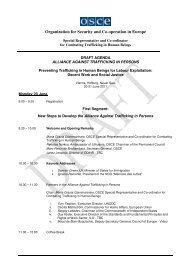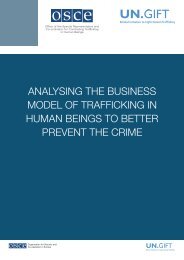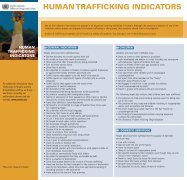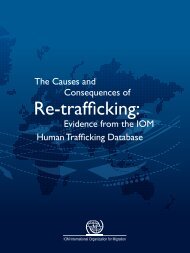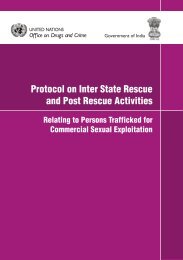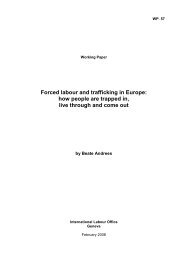An Introduction to Human Trafficking - United Nations Office on ...
An Introduction to Human Trafficking - United Nations Office on ...
An Introduction to Human Trafficking - United Nations Office on ...
You also want an ePaper? Increase the reach of your titles
YUMPU automatically turns print PDFs into web optimized ePapers that Google loves.
AN INTRODUCTION TO HUMAN TRAFFICKING: VULNERABILITY, IMPACT AND ACTION<br />
legislati<strong>on</strong> and a rise in law enforcement activities (police training, arrests, trials, c<strong>on</strong>victi<strong>on</strong>s<br />
and sentences) indicate that efforts have been made. Some victims of trafficking have<br />
been identified and provided with shelter and/or other forms of assistance. It is more difficult<br />
<str<strong>on</strong>g>to</str<strong>on</strong>g> identify the impact of these efforts: few baseline data exist <str<strong>on</strong>g>to</str<strong>on</strong>g> provide a c<strong>on</strong>text<br />
against which <str<strong>on</strong>g>to</str<strong>on</strong>g> assess progress. In the case of preventi<strong>on</strong>, it is even harder <str<strong>on</strong>g>to</str<strong>on</strong>g> determine<br />
the extent <str<strong>on</strong>g>to</str<strong>on</strong>g> which measures have been effective.<br />
Despite a lack of c<strong>on</strong>sensus <strong>on</strong> the actual extent of global human trafficking, experts<br />
n<strong>on</strong>etheless report that the crime is increasing. 2 C<strong>on</strong>ferences open with energetic statements<br />
related <str<strong>on</strong>g>to</str<strong>on</strong>g> the growth of human trafficking, often referred <str<strong>on</strong>g>to</str<strong>on</strong>g> now as a form of<br />
“modern-day slavery”. Poignant illustrative examples describing heart-wrenching abuse<br />
and exploitati<strong>on</strong> are intended <str<strong>on</strong>g>to</str<strong>on</strong>g> reinforce the commitments of Governments, civil society<br />
and d<strong>on</strong>ors.<br />
Those who have had direct c<strong>on</strong>tact with trafficked pers<strong>on</strong>s readily validate such accounts<br />
of human suffering. 3 Many advocates hold <strong>on</strong> <str<strong>on</strong>g>to</str<strong>on</strong>g> vivid memories of emoti<strong>on</strong>ally wounded<br />
and physically beaten human beings as indelible reminders of the reality of the cause and<br />
as powerful incentives <str<strong>on</strong>g>to</str<strong>on</strong>g> c<strong>on</strong>tinue fighting the good fight. But the battle must be w<strong>on</strong> not<br />
<strong>on</strong>ly in the hearts of the public, but also in the minds of policymakers and d<strong>on</strong>ors.<br />
Effective policy requires valid and reliable informati<strong>on</strong>. Experts have so far been hard<br />
pressed <str<strong>on</strong>g>to</str<strong>on</strong>g> explain what an increase in human trafficking means in real terms. 4 Are they<br />
referring <str<strong>on</strong>g>to</str<strong>on</strong>g> more arrests, prosecuti<strong>on</strong>s and (with luck) c<strong>on</strong>victi<strong>on</strong>s? Do they include all<br />
forms of trafficking, such as labour and organ trafficking <str<strong>on</strong>g>to</str<strong>on</strong>g> name <strong>on</strong>ly two, or are they<br />
limiting themselves <str<strong>on</strong>g>to</str<strong>on</strong>g> trafficking for sexual exploitati<strong>on</strong>? Are the speakers perhaps talking<br />
about the numbers of men, women and children rescued in brothel and/or sweatshop<br />
raids? Perhaps they mean individuals in possessi<strong>on</strong> of fraudulent travel documents or<br />
deported as illegal migrants? Or the numbers of individuals identified as victims of trafficking<br />
according <str<strong>on</strong>g>to</str<strong>on</strong>g> the laws and (most frequently) practices of a country and assisted<br />
through shelters or other social service organizati<strong>on</strong>s? <str<strong>on</strong>g>An</str<strong>on</strong>g>d what about the rapidly expanding<br />
forms of trafficking bey<strong>on</strong>d the purposes described in the <str<strong>on</strong>g>Trafficking</str<strong>on</strong>g> Pro<str<strong>on</strong>g>to</str<strong>on</strong>g>col, stemming<br />
in particular from innovati<strong>on</strong>s in medical technology and not yet known when the<br />
<str<strong>on</strong>g>Trafficking</str<strong>on</strong>g> Pro<str<strong>on</strong>g>to</str<strong>on</strong>g>col was being drafted? 5<br />
Such indica<str<strong>on</strong>g>to</str<strong>on</strong>g>rs and others are used <str<strong>on</strong>g>to</str<strong>on</strong>g> dem<strong>on</strong>strate the increase in trafficking and trafficking-related<br />
crimes. <str<strong>on</strong>g>An</str<strong>on</strong>g>d, while the above informati<strong>on</strong> collectively paints a picture of<br />
2<br />
See, for example, Kevin Bales, Understanding Global Slavery: a Reader (Berkeley, California, University of<br />
California Press, 2005).<br />
3<br />
The author includes herself in this category.<br />
4<br />
William Easterly, “Foreign aid and developing ec<strong>on</strong>omies”, transcript of a panel discussi<strong>on</strong>, Council <strong>on</strong> Foreign<br />
Relati<strong>on</strong>s, New York, 16 May 2006.<br />
5<br />
<str<strong>on</strong>g>An</str<strong>on</strong>g> example of a disturbing new trend is the harvesting and trafficking of human eggs <str<strong>on</strong>g>to</str<strong>on</strong>g> be used in in vitro<br />
fertilizati<strong>on</strong> (IVF) treatments. The documentati<strong>on</strong> has been limited <str<strong>on</strong>g>to</str<strong>on</strong>g> date, but is of such a provocative nature that<br />
the European Uni<strong>on</strong> has issued the “European Parliament resoluti<strong>on</strong> <strong>on</strong> the trade in human egg cells”, Official Journal<br />
of the European Uni<strong>on</strong>, C 320 E, 15 December 2005 (P6_TA(2005)0074).<br />
60





